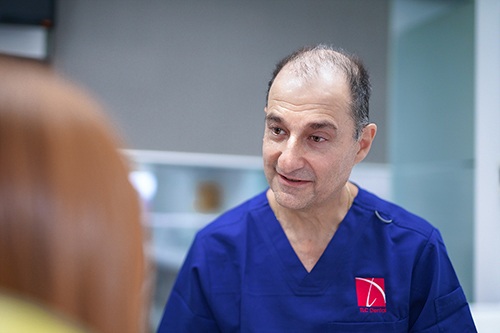Home Teeth Care
How to Brush, How to Floss, Diet
You can make a huge difference in how your teeth look and last with regular, responsible dental care.
HOW TO BRUSH
There are a few different methods considered acceptable when brushing your teeth. Whatever method you use, take the time to brush thoroughly with a recommended toothpaste every day. TLC Dental recommend the following method to help maintain for dental health and easily getting rid of plaque:
1. Place the head of your toothbrush beside your teeth, with the brush tips at a 45 degree angle against your gum.
2. Move the brush back and forth in short, semi-circle strokes several times.
3. Brush the outer surfaces of each tooth, top and bottom, keeping the bristles angled against your gum.
4. Use the same method on the inside surfaces of all the teeth, still using short back and forth strokes.
5. It is important to brush the chewing surfaces of the teeth and they will be constantly in contact with everything you put in to your mouth.
6. You must also clean the inside surfaces of the front teeth by tilting the brush vertically and make several gentle up and down strokes with the front part of the brush.
7. You should not forget your tongue, brushing it will help freshen your breath and clean your mouth by removing bacteria.

BASIC FLOSSING TIPS
An essential part of your routine, flossing removes plaque from between the teeth, areas where gum disease can begin. It can sometimes feel a little awkward to floss, talk to the TLC Dental team and follow the tips below to help you feel more comfortable in maintaining your oral health.
1. Wind roughly 20cm of floss around middle fingers of each hand. Hold each end of the floss between your thumbs and index fingers, leaving about 2cm to 3cm of length in between. You should use your thumbs to direct the floss between your upper teeth.
2. Keeping the 2cm to 3cm length of floss nice and firm between fingers, use index fingers to direct the floss between the lower teeth.
3. Gently ease the floss between the teeth by using a zigzag motion. It is important to remember not snap the floss between your teeth but using a smooth and flowing motion around each side of the tooth.
4. Slide the floss up and down against your tooth surface and under the gum. This may feel awkward but it is important to get underneath the tooth to clean those areas.

DIET
Everyone knows that sugar promotes cavities. But there are other concerns if you don’t eat well. If your diet is low in certain nutrients, you may be more susceptible to mouth infections and this can contribute to periodontal (gum) disease, the main cause of tooth loss in adults.
Although poor nutrition doesn’t actually cause periodontal disease, many researchers believe that the disease progresses faster and is more severe in patients whose diet does not include the necessary nutrients.
GOOD NUTRITION
Choose from the four basic food groups: fruits and vegetables, breads and cereals, milk and dairy products, and meat, fish and eggs. Avoid soft, sweet, sticky foods, such as cakes, candy and dried fruits, that cling to your teeth and promote tooth decay. Instead, choose nuts, raw vegetables, plain yogurt, cheese, popcorn and sugarless gum or candy.
FOR CHILDREN
Obviously a diet low in sugar and high in fresh vegetables and fruit is essential but calcium is also an important part of their daily diet. It is essential for the growth of strong bones and teeth. TLC Dental recommend that children should meet their calcium needs by eating dairy foods and having a well balanced diet.
Sugary foods are difficult to minimise and our advice is to limit these and ensure that your child consumes these food in on sitting. This will reduce the amount of time that you child’s teeth are under attack.

| Monday | 8:00AM – 6:00PM |
| Tuesday | 1:00PM – 7:00PM |
| Wednesday | 8:00AM – 6:00PM |
| Thursday | Closed |
| Friday | 8:00AM – 5:00PM |
| Saturday | Closed |
| Sunday | Closed |
